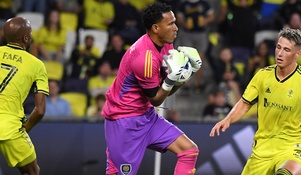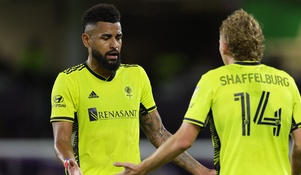NYCFC Clinches MLS Playoff spot
With a 4-1 home victory against the Chicago Fire on Friday night and a New York Red Bulls 1-0 win over the Montreal Impact on Saturday night, New York City Football Club has clinched a historic first playoff berth for the 2016 MLS cup. NYCFC clinched alongside city rivals New York Red Bulls and Toronto FC, who are all even on points at the end of match-week 29 at 48 each. Both NYCFC have 3 to play, while Toronto has 4 matches remaining. It’s going to be down to the wire as the three teams battle for the top of the east and the two first round byes in the MLS Playoffs.
The mathematics to the triple-clinch is a bit odd, but understandable. In order for either of the current top 3 to drop below the line, they’d have to be passed by the 5 other teams above the playoff line as well as the 7th placed team, currently the New England Revolution. In order for this to happen, either NYC, RB, or Toronto would have to lose all remaining matches, and the Revs would have to win their last 4 and pass the team on goal difference (difficult, as the Revs stand at -12 GD, NYC at +2, Toronto at +12, and RB at +13). The problem however, is that one of the Revolution’s matches is against Montreal, who due to their loss against the Red Bulls, can finish with a maximum of 50 points. If the Revolution were to win all remaining games, Montreal would finish with a maximum of 47 and couldn’t pass any of the top 3.
The Revolution would go on to lose Sunday night against Columbus, which would have clinched playoff spots for the three teams even if the Red Bulls had lost or tied.
NYCFC, who finished under the red playoff line in their inaugural season made drastic changes to their team. New manager Patrick Vieira made many moves in the offseason, bringing in players like Costa Rican Rónald Matarrita as well as French Maxime Chanot and Frédéric Brilliant in defense. Striker Patrick Mullins, defender Chris Wingert, and fan favorite midfielder Kwadwo Poku have departed to DC United, Real Salt Lake, and minor league Miami FC respectively. Designated players David Villa, Frank Lampard, and Andrea Pirlo have all been phenomenal this season. Villa stands second in the golden boot race, just behind Bradley Wright-Phillips of the Red Bulls. Pirlo has a fair amount of assists and has helped create great chances and goals. Lampard came back from injury this season to score 12 goals in 18 matches, 15 started, including the club’s first hat-trick in a 5-1 win over Colorado and a brace with a stoppage time winner against DC.
So, what’s been working for NYCFC? What hasn’t? City has had a pretty interesting past couple months, with both positive and negative results impacting them and their playing style. To better understand their current situation as they prepare for the playoffs, it’s high time we look into the factors in their gameplay.
Patrick Vieira’s possession playing style
Pros
- Keeps big teams out of possession
- Allows NYC to control the pace of the game
- Inviting pressure opens up the midfield and attacking third
Cons
- MLS is attacking style soccer, possession often doesn’t work
- NYC isn’t the best at ball movement, possession is often lost
- Yankee Stadium has tiny dimensions. It’s easy to close up space and makes passing lanes from the back difficult to find
- Away from home, City finds it difficult to hold control of the ball
- NYC’s defensive line has been a weak spot since last year
Watching the recent NYCFC home match against FC Dallas gave a prime example of gameplay under Patrick Vieira’s European style of possessive soccer, playing the ball from the back. Goalkeeper Josh Saunders and defenders Jefferson Mena and Frédéric Brilliant passed the ball around between each other A LOT. Saunders took almost every goal kick short to Mena, playing slowly from the back. This playstyle invites a lot of pressure, and when it’s coming from the club in MLS with the highest point total, it’s no wonder possession was often lost in the midfield and often in the defending third.
Playing the ball short and from the back doesn’t work very well at Yankee Stadium. The object of this play style is to invite pressure to open up an attacking path. This is ineffective at Yankee Stadium, however. The field is so small that pressuring isn’t dangerous for opposing teams. Defending players are able to stretch further downfield while still being able to cover ground and cut out passes and runs. Away from home, this method works to an extent. Pressure is typically not as heavy, allowing NYC to play the ball well. Despite this, City has often been careless in possession, giving the ball away with poor passes.
Given Vieira’s career, it’s easy to see why he feels comfortable with this style of play. It’s very rooted in European management, and with his time in the historic Arsenal team, French national team, and Manchester City youth academy, it makes sense that he’s well versed with it. The problem is, MLS is a very different style of soccer. Stateside, teams tend to rely on heavy attacking, not slow buildup. Teams are often seen countering and alternating attacking sequences against each other. Possessive play works against this, and at the moment, is having only limited success. Until Vieira and City have figured out how to consistently play this way, it’s better to perhaps tone it down a little.
Speed vs skill
NYCFC is a team with a clash of both old players and young, offering a combination of players skilled on the ball, and quick in possession. At the moment, many youngsters are sidelined, allowing the DPs and other older players to work the field of play. This makes sense, as these players are more skilled on the ball and are paid for a reason. This however, comes at a cost. Countering attacks is easily the most effective way to score goals in MLS, but when the attack consists of Pirlo, Lampard, Iraola, and Villa, it gives a lot of time for teams to get enough numbers back in defense. There are many moments when speed is lacking, but it’s evident as well that playing speed comes with it’s own sacrifices. Khiry Shelton is a very quick player both on the ball and off it, but often times he loses possession or loses control himself. Steven Mendoza is often found making powerful runs on the ball, but when it comes to laying it off to teammates, attacks slow down or peter out. Relying on speed also hits against stamina, so the use of quick players as subs makes sense.
With Frank Lampard sidelined until the dawn of the playoffs, there’s a spot to fill in the midfield. The question now is on whether it will be filled with technical ability or a burst of speed. In the match against the Fire, Steven Mendoza was given the start in the midfield, scoring a stunning curling goal to cap the scoring in the 4-1 victory. Shelton started on the wing with McNamara on the other. Shelton worked well on the ball, totaling 3 assists in the match. Other players to fill the void include Mikey Lopez, Medhi Ballouchy, Mix Diskerud, and Federico Bravo. Of these four, Lopez and Ballouchy have been sidelined and Diskerud hasn’t made the team sheet since early in the season. Bravo has played often, switching with Andoni Iraola, but picking up many cards, including a controversial red card against New England on September 10th. With Jack Harrison, Tony Taylor, Khiry Shelton, and David Villa as attacking options, with Mendoza able to play in attack or midfield, there are plenty of options for Vieira to choose from.
Weak defense
There is no question about it, NYC’s defensive line is not very scary to most teams. City has had countless problems with their back 4 both in their first season and in this one. There have been many new changes, bringing in Rónald Matarrita, Maxime Chanot, and Frédéric Brilliant, but even so, the back line has proven inconsistent. Matarrita is the one player who regularly starts, and has done an absolutely phenomenal job both in forward play and in defense, including a last second goal line clearance against Orlando. Jefferson Mena has been at fault many times, giving away the ball in dangerous defensive positions and closing opponents down poorly, leading to many goal-scoring chances. The Chicago match showed a difference, as Mena played well, scoring the opening goal off of a headed center by Shelton. If Mena can use the match to start a bout of good form, Chanot, Brilliant, RJ Allen, and Jason Hernandez can play well, with Matarrita playing as he has, NYCFC can surge at the exact right time.
Home field advantage
Getting above the red playoff line is one accomplishment, but an even bigger one is clinching a top 2 divisional finish. Doing so clinches a bye in the first round of the playoffs, avoiding the one game elimination matches and going straight to the 2-leg conference semifinals.
Playing in 2 legs allows NYC to maximize the advantage they play with at home. With such a small field and interesting complications such as the sodding that covers the Yankee Stadium infield poses huge problems for opponents, problems that NYC is used to facing. With 2 legs, a huge advantage in one provides a big chance to move along, and Yankee Stadium has a distinct advantage over other stadiums, even past the atmosphere. NYCFC has also recorded one of the best records away from home in MLS this season, so the 2-leg rounds seem favorable to the boys in blue.
Keys to success:
- Utilize Yankee Stadium dimensions
- Keep a strong back 4
- Keep possession in the midfield
- Continue to get results away from home (at Houston and at DC)
- Finish the season on a high point
- Keep a level head
- Hype up the fans
There are 12 teams in the MLS playoffs, each capable of winning matches in the right way. The path to the cup is no cakewalk, but NYC may be up to the challenge.




